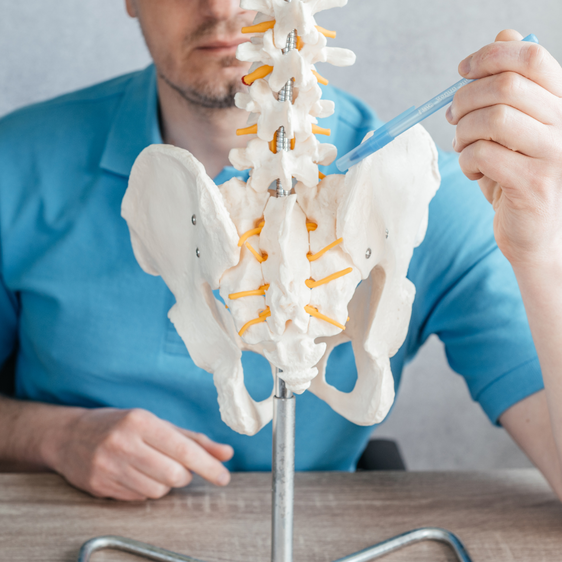|
By Duke Autret Many, if not most people will have heard of, or may even have experienced sciatic pain or sciatica, but what is it exactly? Let’s explore. Sciatica is a term that gets thrown around alot but the fact is that it’s quite a vague term which is used simply to describe any condition where the symptoms involve pain running from the lower back down either one or both legs (potentially all the way down to the foot). Pain types can be sharp, shocking, tingly, numb, cause pins and needles, or cause pinching or catching sensations on movements.  So in fact Sciatica describes not one single condition, but rather a set of symptoms, and that these symptoms that we call Sciatica can be the result of a number of different mechanisms or conditions. To be more precise, Sciatic refers to the name of the nerves which branch out from origins in the lower spine/back and then splits into two Sciatic nerves - one for each leg, and thus innervates the muscles and structures of the legs. However this nerve can become vulnerable to irritation by pressure bearing on it from other structures, when this happens the experience is Sciatica! As mentioned before there can be a variety of reasons for this impingement on the Sciatic nerves and some examples can include pressure from a tight Piriformis muscle (which the sciatic nerve passes directly through or beneath), pressure from an Intervertebral Disc bulge/herniation of the lumbar spine (lower back), Stenosis which is the narrowing of the spinal canal, Spondylolisthesis which is the slipping of one vertebrae over the next and that can pinch the sciatic nerve, or Spondylosis, an arthritic joint degeneration at the lumbar vertebrae which may cause inflammation and subsequent pressure and irritation from that. As we can see, there are many ways in which the sciatic nerve can become impacted and the end result is the same experience and symptoms we call ‘Sciatica’. Some of these situations sound scary, but the majority of the time it is easy to get the pain under control while working with an experienced Myotherapist who can help guide you or refer you on if your condition is particularly acute or severe. Since the irritation that occurs to the Sciatic nerve is to do with some or other kind of pressure, then the priority for treatment becomes to create more space for the nerve to be free, as nerves also need to be able to slide and move with the rest of the body. Importantly, the treatment we use will be dependent on which of the various mechanisms are at play, but commonly any technique employed will be with the aim of creating more space for that nerve, and most often will involves treating the muscles of the lower back, pelvis, hips, glutes and back of the thighs and maybe even calves. Some of these techniques can include hands on options like remedial massage and myofascial release, or helpful nerve gliding movements that can help reduce the sensitivity of those nerves. And in situations where the symptoms are very acute, fresh and severe often Myofascial Dry Needling is a go-to in order to take the edge off and tone everything right down without adding any more undue pressure to the nerve/system. Myotherapists can also provide joint mobilisations to aid in better mobility of the lower back and hips. Mobilisations vary from manipulations - we won't be "cracking your bones", but gently encouraging rhythmic movement to return to your joints without any high velocity cracks or crunches. From here we would look at tailored exercises for your situation which could simply be stretches for a few key tight muscles to a full program to help build stability around the spine and support the structure for healthy nerve function. Some common exercises you might try could be deep abdominal work, diaphragm ‘weight-lifting’, the sphinx, Piriformis stretches, and Glute and Adductor strengthening. Our practitioners will demonstrate these types of exercises and how to safely do them while you're experiencing sciatica, and we can assist you in progressing them as preventative care exercises once the intensity of your pain has eased. If you or anyone you know is currently suffering with Sciatic pain, please come and see us, we are here to help. Just call or leave a message with us at the Simple Wellness Myotherapy clinic here in Rowville, or alternatively you can see our booking schedule and make an appointment yourself for a time that best suits.
Whats Causing This Pain Where My Lower Back And Hips Meet? It Could Be The Sacroiliac Joint10/8/2022
By Duke Autret Pain across the very base of your spine where your hips and lower back meet is very common. You can often pinpoint the pain as starting from "those two dimples at the lower back" and spreading out across the sides of the hips. Those two dimples, which aren't always visible on everyone, are where the back and hip join - specifically where the sacrum bone joins the iliac crest of the pelvis. This joint is called the Sacroiliac Joint. Sacroiliac Joint (SIJ) Dysfunction is an often used term to describe any issue that arises from some kind of problem at this joint, usually leading to the joint becoming inflamed, and which can commonly have subsequent implications such as sciatic pain (pain running down the leg) and/or pain from muscle spasms usually at the lower back and/or around the hip/s.
One reason for this is that the inflammation at the site of the Sacroiliac Joint may irritate the sciatic nerve much in the same way as a spinal disc problem can, although rather than perhaps a bulging intervertebral disc impinging on the sciatic nerve, instead it can be the chemical irritation and/or the pressure and compression caused by the swelling and inflammation of locals tissues and fluids. Then due to pain and irritation from the inflammation, a pain cycle may set in, with muscles spasming and tightening up in response. Our bodies are pretty marvellous in the way they try to protect us from a perceived problem, and that protection usually comes in the way of tensing, tightening or spasming. Consider if you were going to be punched in the gut, the first thing your body will naturally do before you probably even think about it is to tense your abdominals, draw in the arms and shoulders, and crunch forward in a protected position to lessen the blow. The SIJ does a similar process to try to protect around the joint area, which can lead to that persisting pain. Typically, an SIJ issue will present on just one side at a time, although it can be possible for the symptomatic side to swap from one side to the other, as when one SIJ is dysfunctional then the adjacent SIJ compensates and is therefore implicated. The good news is that you can get treatment for Sacroiliac Joint Dysfunction! Treatments we can provide to help when someone comes to us in an acute phase will revolve around ways of decreasing the muscle spasm and pain to the hip, pelvis and spinal regions, and to also advise you on the best ways to manage the joint inflammation itself and ‘deload’ the structures involved. The initial stages of the treatment are likely to involve some soft tissue work like remedial massage, myofascial release, cupping or dry needling, and can also involve taping the SIJ to support that area and give those really hard working muscles a chance for a break without leaving that joint feeling vulnerable. Then once these initial symptoms are under control we will guide you towards how to regain and develop the stability, mobility and control to the specific areas needed, which are likely to include the thigh muscles and the deep muscles of the trunk, abdominals, and back. Outside of any hands on treatments the lasting success of reversing this type of condition will depend also on the empowerment of you. We will advise you on the best rehab routine and provide a layered program over time so that you can progress at the right pace and without worrying about being overloaded with homework. Or alternatively, we can refer you to connect with local practitioners or instructors in clinical exercise or other modalities like yoga for example if you prefer or if help with motivation and supervision is what you need. Personally I enjoy working with SIJ pain since I used to suffer from a lot of it myself (and know how difficult it can be) and because I’ve learned how to best deal with it, to the point where I no longer suffer from this anymore. This has been a worthy investment for me and also a gift. I hope to share this with those who need it too. If you’d like to start down the road of finding ways to improve your own challenges with an SIJ issue, I am here to help. Just call or leave a message with us at the Simple Wellness Myotherapy clinic here in Rowville, our number is 03 8204 0970, or alternatively you can visit our website to see our booking schedule and make an appointment for yourself at a time that best suits you. Getting a Remedial Massage or Myotherapy appointment is becoming even easier now that we have two new therapists joining our Rowville team! Join us in welcoming our two great new practitioners to the Simple Wellness clinic! Kel Levi will be joining us from Wednesday July 27th. Kel is an experienced Myotherapist who is currently working alongside AFL Premiers Melbourne Football Club helping their players during and after their matches. She's also a qualified personal trainer, and has a wealth of knowledge in the health and fitness realm. She has a great firm massage style, loves to use dry needling to help reduce pain and improve movement, and can use her extensive background in fitness and exercise to help you find ways to stretch and strengthen your trouble areas with ease. Myotherapy and Remedial Massage with Kel can be claimed through our HICAPS machine with private health insurers like BUPA, Medibank, HCF and all other health insurers. Kel will be available: Mondays and Wednesdays 9-12, and occasional Fridays (when Melbourne Footy Club don't need her expertise in the club rooms!) Colette Corr is our new student Myotherapist, who is starting with us on Tuesday August 2nd. Colette is a final year Bachelor of Health Science Myotherapy student, which means she's completed the vast majority of the 3 year Bachelor degree program and is down to the last few subjects, including student clinical hours. We'll be offering discounted treatments with Colette while she's finishing up her degree. In addition to Myotherapy, Colette is also a yoga instructor with over 5 years experience, and loves to work with people with chronic pain and hypermobility/Ehlers Danlos Syndrome. As Colette is a student, private health claims can't be made for treatments with her. Colette will be available: Tuesdays 2-7 and Saturdays (alternating between morning and afternoon shifts) As always, bookings with our team of fantastic therapists can be made instantly online or by phoning us on 03 8204 0970.
|
Meet Our Team
We have a team of great practitioners available 7 days a week at our Rowville clinic. Archives
July 2024
Categories
All
|
Got a question about Myotherapy?
Contact Mel by phone, email or Facebook
|
Simple Wellness Myotherapy & Remedial Massage Clinic
Shop 12B 150 Kelletts Rd Rowville VIC 3178 |
Phone us on
03 8204 0970 |





 RSS Feed
RSS Feed